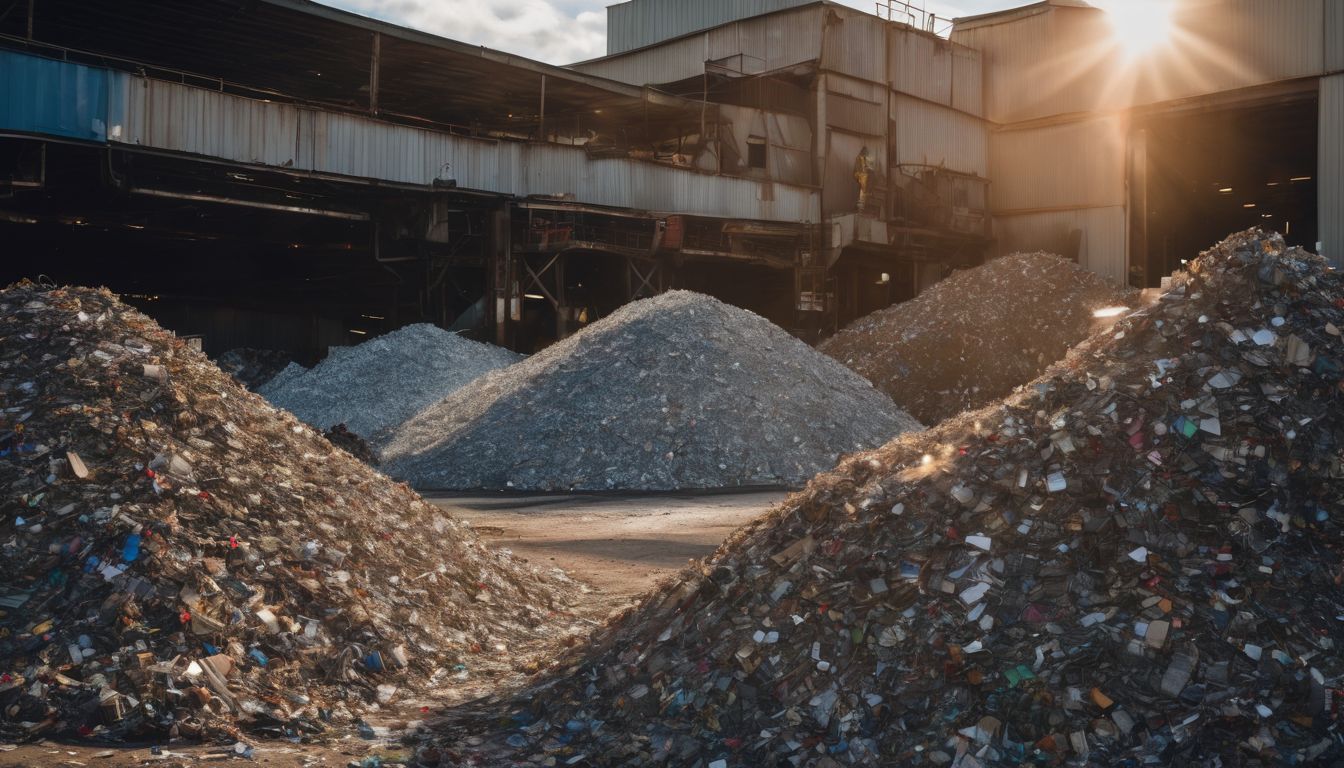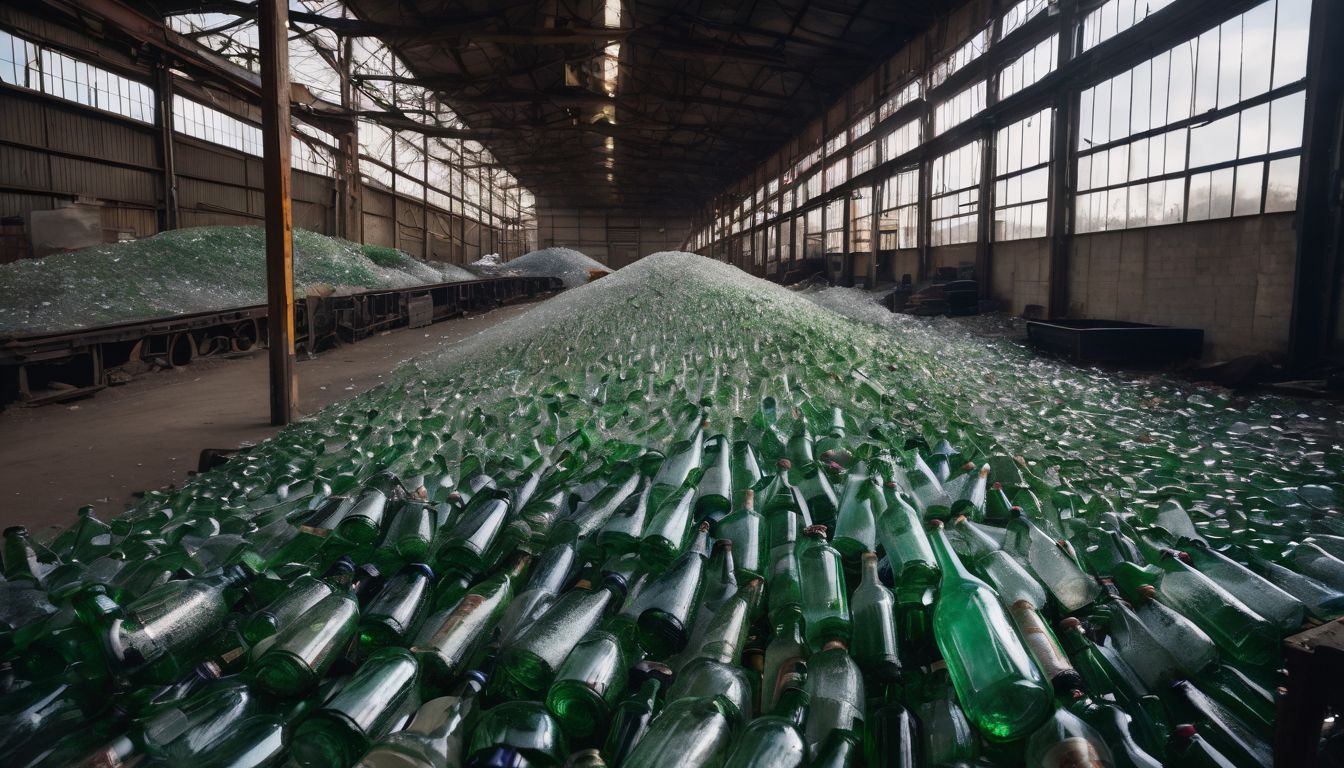Ever struggled to figure out what to do with those old light bulbs or worn-out shoes? Every year, tonnes of unusual items end up in landfills when they could be recycled. This guide promises to demystify the maze of recycling the bits and bobs you never knew had a second life.
Dive in for eco-smart solutions!
Key Takeaways
- Recycling is not just for common items like paper and plastic, but also unusual ones such as textiles, electronics, batteries, and even paint.
- Proper disposal of hazardous materials including light bulbs, tyres and electronics is crucial to avoid harming the environment.
- Find local recycling facilities or special collection events organised by your council to recycle or dispose of unusual items correctly.
- Upcycling old clothes or reusing household items are great ways to reduce waste. Creatively repurpose textiles and participate in clothing swap events to give old garments new life.
- Recognise recycling symbols on packaging to sort recyclable items accurately and explore alternative eco-friendly materials for everyday use.
The Basics of Recycling
Recycling is the process of converting waste materials into reusable objects. It is important for conserving natural resources and reducing pollution.
What Is Recycling?
Recycling means transforming used materials into new products to prevent waste of potentially useful resources and reduce the consumption of fresh raw materials. This ecofriendly process helps conserve energy, minimise greenhouse gas emissions, and lessens the demand for waste disposal in landfills.
It allows us to take everyday items like paper, glass, plastic, and metal, break them down, and turn them into something new. Households play a vital role in this cycle by separating their rubbish appropriately.
We all can contribute to environmental conservation through recycling. In the next section we’ll explore why it’s so important for sustainability and how it benefits not just our homes but also the wider environment.
Importance of Recycling
Recycling plays a crucial role in reducing waste and conserving natural resources. By recycling materials like paper, plastic, glass, and metal, we can significantly decrease the amount of waste sent to landfills.
This not only helps in preserving the environment but also contributes to energy conservation and reduces air and water pollution. Additionally, recycling supports sustainable living practices by promoting the efficient use of resources and reducing the need for raw material extraction.
Reusing items through recycling not only lessens our environmental impact but also encourages responsible waste management. Household recycling tips can help individuals play an active part in creating a positive change towards a more eco-friendly future.
What Can Be Recycled?
Recycling is important for conserving resources and reducing waste. Common recyclable items include paper, plastics, glass, metal, batteries, electronics, hazardous materials, food waste, lawn materials, used oil and household hazardous waste.
Paper/Cardboard
Recycling paper and cardboard is a crucial step in reducing waste. Gather newspapers, magazines, cardboard boxes, cereal boxes, junk mail, and office paper to recycle at your local recycling facility.
Sorting your paper and cardboard according to type makes it easier for the recycling process. Ensure that the items are clean and dry before placing them in the recycling bin. By taking these simple steps, you can help conserve natural resources while reducing pollution from producing new materials.
Moving on to another unusual item – textiles. Recycling textiles such as old clothes and fabrics helps reduce landfill waste significantly.
Plastics
Moving on from the recycling of paper and cardboard, let’s now delve into the world of plastics. Plastics are widely used in our daily lives, but they also pose a significant challenge when it comes to proper disposal and recycling.
However, many types of plastics can be recycled, including PET bottles, HDPE containers, PVC piping, and LDPE packaging. It’s crucial to pay attention to the resin identification codes (RIC) found on plastic products which indicate their recyclability.
By incorporating a few simple practices such as rinsing out containers before recycling them and avoiding mixing different types of plastics together, we can significantly contribute to reducing plastic pollution and conserving valuable resources.
Glass
Moving from plastics to glass, it’s important to note that glass is 100% recyclable. It can be recycled endlessly without losing its quality or purity, making it an environmentally friendly option.
When glass is thrown into landfills, it takes over a million years to decompose; however, when recycled, it goes back into the production cycle and reduces the need for raw materials.
Glass recycling not only conserves natural resources but also saves energy. By using recycled glass to make new bottles and jars, manufacturers can reduce energy consumption by up to 30%.
Metal
When recycling metal, it’s essential to separate different types. The most common metals recycled include aluminium, steel, and copper. Once separated, these materials can be reused in various ways.
Reusing metal reduces the need for mining new raw materials and helps conserve natural resources.
Recycling metal not only reduces greenhouse gas emissions but also saves energy. By melting down scrap metal, manufacturers can create new products without the need for extensive mining and processing.
Batteries
Recycling batteries is essential for protecting our environment. Many types of batteries, including regular alkaline and rechargeable variations, can be recycled to prevent harmful chemicals from contaminating the soil and water.
Finding a recycling location that accepts batteries is crucial in promoting eco-friendly practices.
When disposing of old or used batteries, remember to look for specific recycling symbols on the packaging. This helps ensure proper disposal techniques are followed and reduces potential environmental damage caused by improper battery disposal.
Electronics
When disposing of electronics, consider recycling options to prevent environmental harm. Old computers, laptops, mobile phones, and other gadgets contain valuable materials that can be reused or repurposed.
Look for local recycling centers that accept electronic waste and ensure they follow proper disposal procedures. Do not landfill electronics as they contain toxic substances harmful to the environment.
Ensure your old electronics are recycled properly by choosing responsible recyclers who adhere to eco-friendly practices. Many electronic retailers provide trade-in programs where you can exchange old devices for credit towards new purchases, promoting a circular economy that reduces waste and conserves resources like metals and plastics used in manufacturing.
Hazardous Materials
When handling hazardous materials, it is essential to follow proper guidelines for disposal. These materials include items such as batteries, electronics, and household cleaning products.
Ensure that these items are recycled or disposed of at designated facilities to prevent harm to the environment.
Properly disposing of hazardous materials can prevent pollution and protect wildlife. Many communities have specific drop-off locations for these items, so be sure to research where you can safely dispose of them.
Food
Food waste accounts for a significant portion of household waste. Instead of throwing away food, composting it can reduce the amount of rubbish sent to landfills. Composting fruit and vegetable scraps, coffee grounds, eggshells, and other organic food waste not only reduces methane emissions but also creates nutrient-rich soil for gardening.
Additionally, donating excess non-perishable food items to local charities or shelters helps minimise food wastage while supporting those in need.
Moreover, being mindful of expiry dates and properly storing perishable foods can prevent unnecessary disposal. Utilising leftovers creatively through meal planning can further reduce food waste and promote sustainable practices in daily life.
Lawn Materials
To recycle lawn materials, collect grass clippings, leaves, and other organic debris. These can be composted to enrich the soil in your garden. Alternatively, check if your local recycling centre accepts green waste for composting.
This can reduce landfill waste and create natural fertiliser for plants.
Consider using a mulching lawnmower that cuts and deposits grass clippings back onto the lawn. This returns nutrients to the soil instead of bagging and disposing of them. Additionally, explore using natural weed control methods like hand-pulling or mulching with newspaper or cardboard rather than chemical herbicides.
Used Oil
When it comes to recycling, used oil can be a tricky item to dispose of properly. Many people are unaware that used cooking oil and automotive oil can actually be recycled. Instead of pouring it down the drain or letting it seep into the ground, you can take your used oil to designated recycling centers where they can process and repurpose it for a variety of purposes such as biodiesel production, lubricant manufacturing, and even energy generation.
Recycling used oil not only prevents environmental pollution but also conserves natural resources by creating new products from something that would otherwise go to waste. By participating in this eco-friendly practice, you contribute to sustainability efforts while embracing an environmentally conscious lifestyle.
Household Hazardous Waste
Household hazardous waste includes items like cleaning products, pesticides, and certain electronics containing toxic substances. These materials should not be disposed of in regular bins due to their potential harm to the environment.
To properly dispose of household hazardous waste, individuals can seek out special collection events organised by local authorities or drop-off locations specifically designated for these items.
It’s crucial to handle and transport these materials according to the guidelines provided by the disposal facility.
How to Recycle Unusual Items
– Recycling unusual items such as textiles, nappies, old clothes and shoes can be done through upcycling or donating to charity shops.
– Proper disposal of paint, barometers and thermometers, light bulbs, and tyres requires special care due to their hazardous nature.
Textiles
To recycle textiles, such as old clothes and linens, start by checking with local charities or second-hand stores. Many of these organisations accept textile donations and will repurpose or sell them for a good cause.
If your items are too worn out for donation, seek out textile recycling centres that can process and reuse the fabric. Look for drop-off locations or collection programmes in your community to ensure that your textiles are recycled responsibly.
Consider exploring upcycling projects at home to breathe new life into old textiles. You could turn t-shirts into cleaning rags, transform jeans into stylish tote bags, or create patchwork quilts from different pieces of fabric.
Nappies
Nappies, often known as diapers, can also be recycled. When disposing of nappies, it’s important to check if there are any local recycling programs available. Some companies offer services where they collect used nappies and recycle the materials into other products.
These eco-friendly practices help in reducing waste sent to landfills, supporting conservation efforts.
Recycling nappies contributes to a more comprehensive approach to waste management. By participating in these recycling initiatives, environmentally conscious individuals can play a vital role in promoting sustainable and eco-friendly practices within their communities.
Old Clothes and Shoes
Old clothes and shoes can be recycled in various ways, contributing to a more sustainable environment. Donating wearable items to charity shops or shelters allows them to be reused by others in need.
Additionally, clothing recycling banks and textile collection points accept old clothes and shoes for recycling into new materials such as insulation, carpet underlay, and industrial rags.
Take the opportunity to contribute positively towards reducing waste by responsibly handling old textiles.
Consider participating in local clothing swap events where individuals exchange unwanted garments, giving them a new lease of life while reducing the demand for new clothing production.
Paint
When disposing of paint, ensure that it is completely dried out. This makes the paint less hazardous and safer to dispose of. Once dry, you can discard it with your regular household waste or take it to a local recycling centre for safe disposal.
Consider using up leftover paint on small projects around the house or donate it to community groups, schools, or charities if there are still usable amounts remaining. Avoid pouring excess paint down drains, as this can lead to water pollution and harm the environment.
Barometers and Thermometers
When recycling barometers and thermometers, it’s essential to handle them with care as they contain mercury, a hazardous material. Find local hazardous waste collection sites or events where you can safely dispose of these items.
Never put them in your regular recycling bin or throw them in the bin where they might break and release mercury into the environment.
Transport old barometers and thermometers in a secure container to prevent any spills during transit. Contact your local recycling centre or environmental agency for guidance on proper disposal methods if you’re unsure.
By handling these unusual items responsibly, you’ll contribute to a safer environment for everyone.
Light Bulbs
Now let’s talk about light bulbs. When a light bulb burns out, it’s tempting to throw it in the bin, but this isn’t environmentally friendly. Instead, recycling them is a great way to reduce waste and conserve resources.
Many recycling centres accept different types of light bulbs – traditional incandescent bulbs, CFLs (compact fluorescent lamps), and LEDs (light-emitting diodes) can usually be recycled.
By properly disposing of your old light bulbs, you are contributing to the effort of creating a more sustainable environment.
To recycle your used light bulbs, check with your local recycling centre or waste management facility for specific instructions on how to do so safely. They may have guidelines on where to drop them off or how they should be packaged for disposal.
Tyres
When it comes to recycling unusual items, tyres pose a unique challenge. While most recycling centres do not accept whole tyres due to their size and composition, there are still environmentally friendly options for disposal.
Reputable tyre retailers and auto repair shops often offer tyre recycling services, where old tyres can be turned into various products like rubber mulch for landscaping or materials for construction projects.
Tyres can also be repurposed creatively at home – from making tyre swings in the garden to using them as planters, there are many ways to give old tyres a new lease of life. Additionally, some local councils host special collection events for used tyres.
Tips for Making Recycling Easy
Find a Recycling Location, Know What Symbols Mean, Proper Disposal Techniques, Making Use of Alternative Materials. To learn more about how to recycle unusual items and make recycling easier, keep reading our comprehensive guide.
Find a Recycling Location
Locating a recycling facility is crucial in ensuring that your recyclable items are properly handled. Search online for local recycling centers or drop-off locations using specific keywords like “recycling center near me” or “nearest paper recycle point.” Another way to find a recycling location is by contacting your local waste management authority or council for information on community recycling programs and collection services.
Consider exploring alternative options such as curbside pickup services provided by your municipality, making it convenient to regularly dispose of recyclable materials. By locating the closest recycling facility, you can stay committed to eco-friendly practices and contribute towards environmental conservation.
Know What Symbols Mean
Look for the recycling symbols on packaging to identify whether an item can be recycled. The most common symbol is the Mobius loop, which consists of three arrows chasing each other in a triangle shape.
Check for this symbol and number codes within it to understand what type of plastic an item is made from. Understanding these symbols will help you make informed decisions when sorting your waste for recycling.
Understanding these symbols enables you to separate recyclable items effectively, reducing contamination in the recycling stream. This simple action plays a vital role in promoting efficient recycling processes and sustainable environmental practices.
Proper Disposal Techniques
When disposing of hazardous materials such as batteries and electronics, it is important to find designated drop-off locations or recycling centres. Proper disposal prevents these items from ending up in landfills, where they can leak harmful chemicals into the soil.
Similarly, used oil should be taken to a collection centre, where it can be recycled rather than being poured down drains or disposed of with regular household waste.
For items like paint and light bulbs, many local authorities organise special collection events for their safe disposal. Contacting your local council or recycling facility can help you learn about upcoming disposal opportunities near you.
Making Use of Alternative Materials
Consider using alternative materials such as bamboo, jute, or hemp instead of plastic and paper. These eco-friendly options reduce the demand for traditional materials and help to lower environmental impact.
Similarly, opting for items made from recycled glass or metal can significantly decrease the need for new resources while also reducing waste. Embracing these alternative materials is a simple yet impactful way to promote sustainability and support conservation efforts.
Moving on to the next section about “Tips for Making Recycling Easy” let’s explore how little changes in our daily routine can contribute towards a greener future.
Conclusion
In conclusion, recycling unusual items is an essential part of eco-friendly practices. It’s important to research local facilities that accept these items. Take the initiative to properly dispose of textiles, nappies, old clothes and shoes, as well as other unusual items.
By doing so, you’re taking a proactive step toward environmental conservation while contributing to a sustainable future for all.
FAQs
1. What is in the “How to Recycle Unusual Items: A Comprehensive Guide”?
The guide gives clear instructions on recycling items that aren’t typically picked up by regular recycling services, helping you follow eco-friendly practices.
2. Why should I recycle unusual items?
Recycling unusual items reduces waste, conserves resources and supports eco-friendly practices for a healthier planet.
3. Where can I find information on how to recycle odd objects?
You can look into our comprehensive recycling guide for detailed steps on handling and recycling various uncommon objects responsibly.
4. Does your guide offer tips for everyday eco-friendly actions?
Yes, our guide includes practical advice on adopting ecofriendly practices in day-to-day life, not just with unusual items but across all aspects of waste management.





